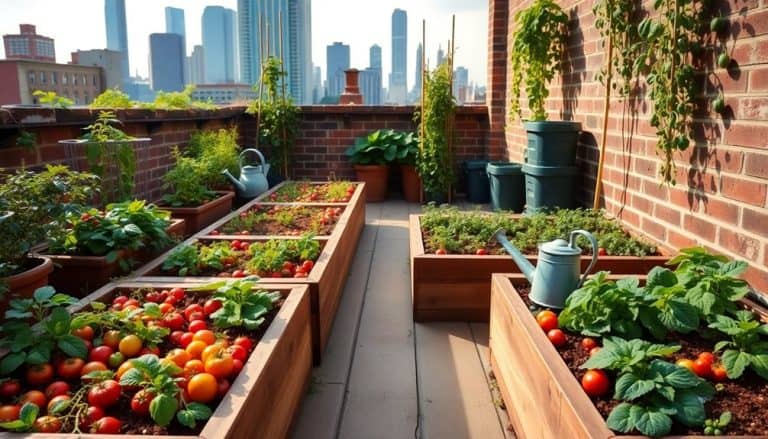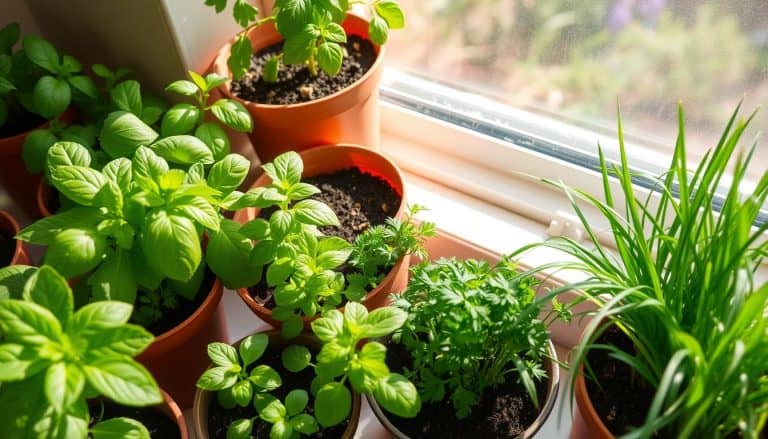This website contains affiliate links. Some products are gifted by the brand to test. As an Amazon Associate, I earn from qualifying purchases. The content on this website was created with the help of AI.
You’ll find several foolproof plants that thrive in shady conditions and require minimal maintenance. Start with hostas, which offer diverse foliage sizes and colors while tolerating USDA zones 3-9. Ferns naturally evolved for low light and provide excellent texture, particularly the hardy Japanese Painted and Lady Fern varieties. Add visual interest with coral bells (Heuchera), featuring striking foliage colors from purple to caramel. Japanese forest grass creates graceful movement with its cascading form, while bleeding hearts contribute dramatic spring blooms. Each of these shade-tolerant plants establishes easily in well-draining, humus-rich soil with proper spacing and basic care techniques.
Key Takeaways
- Hostas are low-maintenance plants perfect for shade, offering diverse foliage colors and requiring minimal care beyond basic watering.
- Ferns thrive naturally in shaded areas and need only consistent moisture and well-draining soil to flourish.
- Coral Bells provide colorful foliage year-round and are hardy in most climates, making them ideal for novice gardeners.
- Ground covers like Pachysandra and Vinca minor suppress weeds and prevent soil erosion with minimal maintenance requirements.
- Astilbe produces beautiful flower plumes in various colors and performs well in dappled shade with consistently moist soil.
Hostas: The Shade Garden Superstar
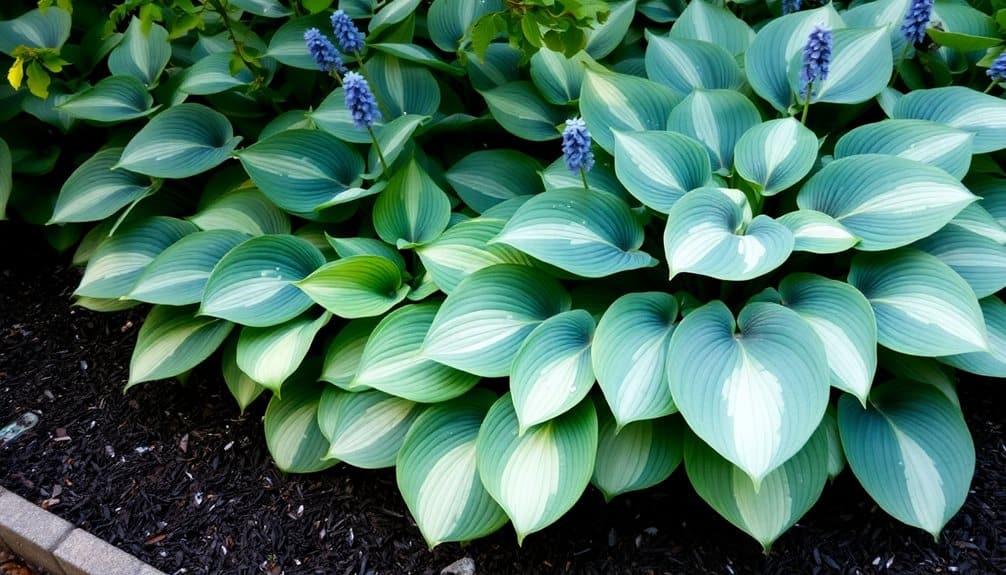
Among all shade-tolerant perennials, Hostas (Hosta spp.) stand out as the most versatile and low-maintenance option for beginning gardeners. You’ll find these herbaceous plants thrive in USDA zones 3-9, producing distinctive foliage in various sizes, colors, and textures. Their leaves range from tiny 2-inch varieties to massive 4-foot specimens, displaying colors from blue-green to chartreuse, often with striking variegation patterns.
You’ll need to plant your hostas in well-draining soil with a pH between 6.0-7.5. While they’re shade-tolerant, they won’t perform well in deep shade; dappled sunlight or morning sun provides ideal growth conditions. Space your plants according to their mature size, typically 2-4 feet apart. You’ll want to divide them every 4-5 years to maintain vigor.
Watch for common pests like slugs and deer, which find hostas particularly appetizing. You can protect your plants using copper tape barriers or commercial repellents. While relatively disease-resistant, they can develop crown rot in poorly draining soils. Water at the base to prevent fungal issues, and you’ll enjoy these low-maintenance beauties for decades with minimal care. Consider enhancing your hosta garden with solar pathway lights to illuminate walkways and highlight their dramatic foliage at night.
Ferns For Low Light Spaces

Throughout shaded garden areas, ferns provide exceptional coverage with their delicate, lacy fronds and architectural presence. These ancient plants have evolved specifically to thrive in low-light conditions, making them ideal candidates for north-facing gardens and spaces beneath tree canopies. You’ll find that ferns’ root systems, consisting of rhizomes, help stabilize soil while gradually spreading to fill shaded spaces.
For beginners, start with hardy varieties like the Japanese Painted Fern (Athyrium niponicum), which displays silver-gray fronds with burgundy highlights, or the reliable Lady Fern (Athyrium filix-femina), known for its adaptability. The Autumn Fern (Dryopteris erythrosora) offers color variations throughout the season, emerging copper-red before maturing to green.
To guarantee success, plant your ferns in well-draining, humus-rich soil with a pH between 5.5 and 6.5. You’ll need to maintain consistent moisture, but avoid waterlogged conditions that can lead to root rot. Space plants 18-24 inches apart to accommodate their mature spread, and apply a 2-inch layer of organic mulch to retain moisture and suppress weeds. Consider incorporating Pure Organic Worm Castings into the soil before planting to improve soil structure and enhance water retention for your ferns.
Colorful Coral Bells

While ferns excel in providing textural interest, Heuchera, commonly known as Coral Bells, deliver striking foliage color to shaded gardens. You’ll find these versatile perennials offer leaves in shades of purple, amber, lime green, silver, and nearly black. They’re hardy in USDA zones 4-9 and maintain their color throughout the growing season.
You can expect Coral Bells to reach heights of 8-18 inches, with flower stalks extending up to 24 inches. The plants form neat mounds of scalloped, rounded leaves with tiny bell-shaped flowers appearing on tall stems in late spring. They’ll perform best in partial shade with well-draining, humus-rich soil at a pH between 6.0 and 7.0.
When you’re selecting Heuchera varieties, consider ‘Palace Purple’ for deep burgundy foliage, ‘Caramel’ for copper-orange leaves, or ‘Citronelle’ for chartreuse coloring. You’ll need to divide these plants every 3-4 years to maintain vigor. Watch for crown rot in poorly draining soils, and remove any damaged leaves to prevent fungal issues. During winter, apply a light mulch to prevent frost heaving in colder regions. When working with these delicate plants, use thin gardening gloves for better dexterity while handling seedlings and performing maintenance tasks.
Japanese Forest Grass

Japanese Forest Grass (Hakonechloa macra) stands out as one of the most elegant ornamental grasses for shade gardens, featuring cascading foliage that creates a waterfall-like effect. You’ll find this slow-growing perennial reaches heights of 12-18 inches and spreads 18-24 inches wide. Its arching stems and chartreuse to golden leaves bring movement and light to shaded areas, making it an excellent choice for woodland gardens or container plantings.
To successfully grow Japanese Forest Grass, you’ll need well-draining, humus-rich soil with consistent moisture. While it thrives in partial to full shade, morning sun can enhance the golden coloration of certain cultivars. Plant it in USDA zones 5-9, spacing plants 18 inches apart to allow for mature spread. You’ll want to divide established clumps every 3-4 years in early spring.
This grass requires minimal maintenance beyond regular watering and annual spring cleanup. Cut back the previous year’s growth to 3 inches before new shoots emerge. You can combine it with hostas, ferns, and astilbe for a dynamic shade garden composition that emphasizes textural contrast. Consider placing Japanese Forest Grass near a UV-resistant greenhouse to provide additional protection during extreme weather conditions while maintaining optimal growing conditions.
Bleeding Hearts In Shade

Among shade-loving perennials, Bleeding Hearts (Dicentra spectabilis) command attention with their distinctive heart-shaped blooms that dangle from arching stems in spring. You’ll find these Asian natives thriving in USDA zones 3-9, where they reach heights of 24-36 inches and spread 18-30 inches wide. The plants prefer rich, well-draining soil with consistent moisture and humidity levels above 50%.
You can plant Bleeding Hearts in areas that receive partial to full shade, though they’ll tolerate morning sun in cooler climates. The foliage emerges in early spring, followed by pink or white blooms that persist for several weeks. After flowering, the plants naturally go dormant in summer’s heat, so you’ll want to position them near companions that can fill the space.
To maintain your Bleeding Hearts, cut back yellowing foliage after bloom time and maintain a 2-inch layer of mulch to retain moisture. You can divide mature plants in early spring or fall every 3-4 years. Watch for common issues like powdery mildew and leaf spot, though these rarely affect the plant’s overall health when proper spacing guarantees good air circulation.
Astilbe For Dappled Light
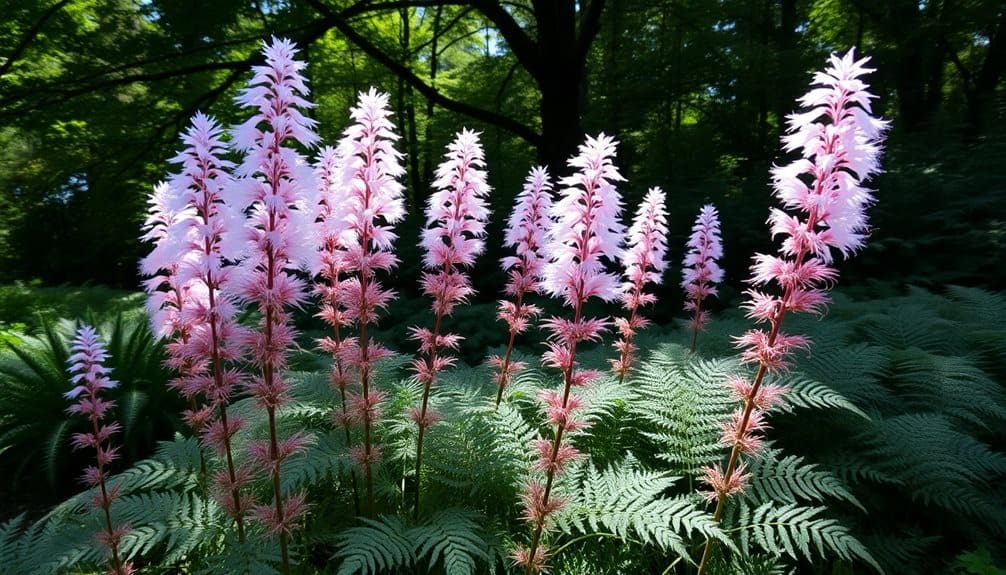
Astilbe adds dramatic plumes of feathery flowers to shaded gardens where Bleeding Hearts have gone dormant. You’ll find these reliable perennials producing striking flower spikes in shades of pink, red, white, or lavender from early to late summer. The plants thrive in dappled shade and require consistently moist, humus-rich soil with a pH between 6.0 and 7.0.
You can expect Astilbe to reach heights of 18-48 inches, depending on the variety. Plant them 18-24 inches apart, as they’ll form dense clumps of glossy, fern-like foliage. Their root systems are shallow, so you’ll need to mulch well to retain moisture and protect the roots. When temperatures exceed 85°F, increase watering frequency to prevent leaf scorch.
To maintain healthy plants, you’ll want to divide Astilbe clumps every 3-4 years in early spring or fall. Remove spent flower plumes to prevent self-seeding, though they’ll often provide winter interest when left standing. Fertilize in spring with a balanced, slow-release fertilizer (10-10-10). You can expect minimal pest problems, though leaf nematodes and powdery mildew may occasionally affect stressed plants.
Woodland Wildflowers
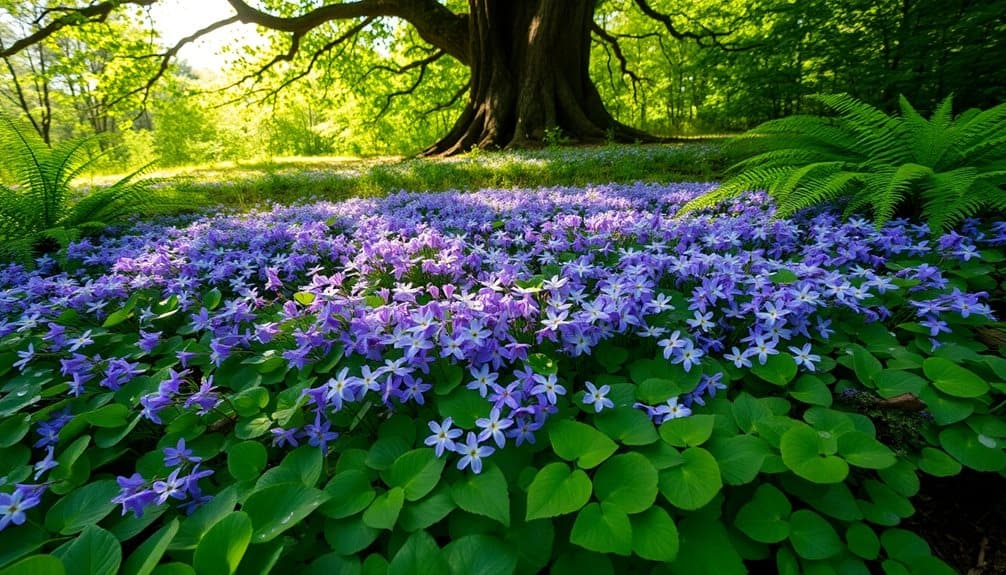
Native woodland wildflowers introduce delicate beauty and ecological value to shaded garden spaces, perfectly mimicking natural forest understory environments. You’ll find these plants have adapted to thrive in low-light conditions beneath tree canopies, making them excellent candidates for challenging shade gardens.
Key species you should consider include Trillium grandiflorum, which produces striking white three-petaled blooms in spring, and Mertensia virginica (Virginia bluebells) with its clusters of pink-to-blue nodding flowers. Hepatica americana offers early-season interest with its purple-blue blossoms, while Sanguinaria canadensis (bloodroot) features distinctive white flowers and unique lobed foliage.
To establish woodland wildflowers successfully, you’ll need to replicate their natural growing conditions. Incorporate organic matter into well-draining soil, and maintain consistent moisture levels without waterlogging. Plant these species in groups of three to five for prime visual impact. Most woodland wildflowers benefit from a 2-inch layer of leaf mulch, which helps retain moisture and gradually decomposes to enrich the soil. You’ll notice these plants go dormant by midsummer, so consider interplanting with ferns or hostas to maintain garden interest.
Hardy Shade-Loving Ground Covers
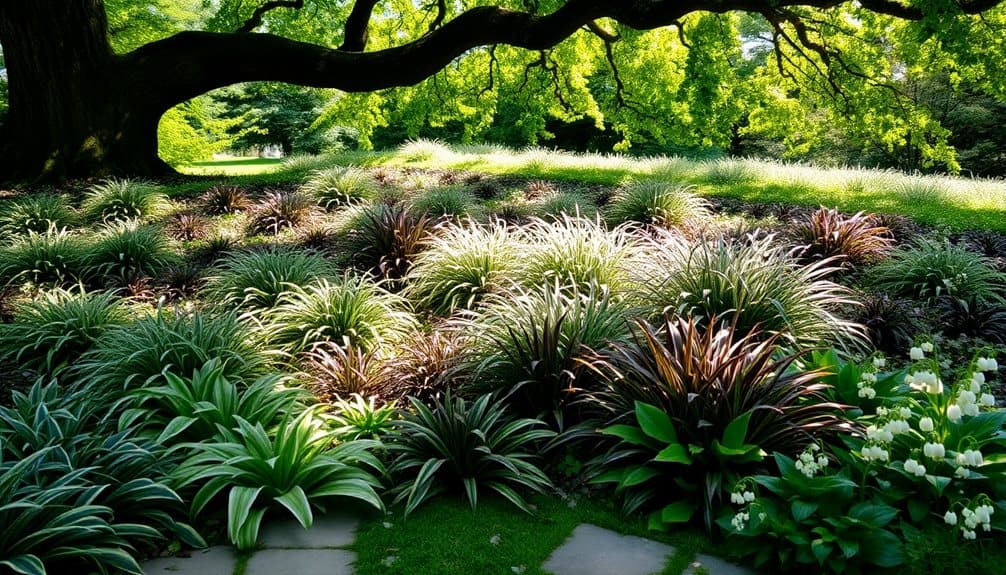
For challenging shade conditions, ground covers serve as essential problem-solvers by providing dense, low-maintenance coverage while preventing soil erosion and suppressing weed growth. You’ll find several reliable options that thrive in low-light environments and adapt well to varying soil conditions.
Pachysandra terminalis (Japanese spurge) forms a thick carpet of glossy, evergreen foliage and tolerates deep shade. It’s particularly effective under trees where grass won’t grow. Vinca minor (periwinkle) offers similar benefits with the addition of purple-blue flowers in spring, though you’ll need to monitor its spreading tendency.
For moist, shaded areas, consider Ajuga reptans (bugleweed), which provides both ground coverage and seasonal interest with its blue flower spikes. Lamium maculatum (spotted dead nettle) thrives in partial shade and features variegated foliage with pink or white blooms. In zones 4-8, Galium odoratum (sweet woodruff) establishes quickly, producing delicate white flowers and aromatic foliage.
When planting these ground covers, space them 12-18 inches apart to allow for spread. You’ll achieve superior coverage within two growing seasons with proper soil preparation and consistent moisture during establishment.
Ideal Soil For Shade Plants

Most shade plants‘ success depends heavily on soil that balances moisture retention with adequate drainage while maintaining proper nutrient levels. You’ll need to create a rich, loamy soil mixture by combining one-third organic matter, such as composted leaves or aged bark, with your existing garden soil. The pH should typically range between 5.5 and 6.5 for ideal nutrient absorption.
To improve drainage in heavy clay soils, incorporate coarse sand or fine gravel at about 20% of the total volume. You’ll want to make certain the soil depth is at least 12 inches for proper root development. Adding a 2-inch layer of organic mulch helps regulate soil temperature and moisture while gradually decomposing to enrich the soil structure.
Test your soil annually and amend accordingly with balanced, slow-release fertilizers. Phosphorus and potassium are particularly important for shade plants, so look for formulations with ratios like 5-10-10 or 3-15-15. If you’re dealing with highly acidic soil, you can raise the pH by adding dolomitic limestone, while sulfur will lower pH in alkaline conditions.
Shade Garden Maintenance Tips

Successful shade garden maintenance requires a systematic approach throughout the growing season. You’ll need to monitor soil moisture levels consistently, as shade gardens typically retain moisture longer than sun-exposed areas. Check soil dampness weekly by inserting your finger 2 inches deep; water only when the soil feels dry at this depth.
Prune dead or declining foliage quarterly to prevent fungal diseases and maintain plant vigor. Remove fallen leaves promptly, as they can harbor pathogens and slugs. You’ll want to apply a 2-inch layer of organic mulch in early spring, maintaining a 2-inch gap around plant stems to prevent crown rot.
Monitor for pest infestations bi-weekly, particularly checking for slugs, snails, and vine weevils. Install copper barriers or apply organic slug deterrents as needed. Fertilize shade-tolerant plants with a balanced, slow-release fertilizer (10-10-10) twice during the growing season: once in early spring and again in mid-summer.
Division of perennials should occur every 3-4 years in early spring or fall to prevent overcrowding and maintain peak growth. When dividing, verify each section contains healthy roots and at least three growth points.
Frequently Asked Questions
Can Shade Garden Plants Survive Winter Without Special Protection?
When winter’s icy fingers grip your garden, many shade-tolerant plants can tough it out naturally. You’ll find that native species and well-established perennials like Hostas, Hellebores, and Ferns have evolved robust survival mechanisms. They go dormant, directing nutrients to their root systems below the frost line. However, you should mulch new plantings with 2-3 inches of organic material to prevent frost heave during the first winter.
How Do Deer-Resistant Shade Plants Compare to Sun-Loving Deer-Resistant Options?
You’ll find that deer-resistant shade plants often contain higher levels of toxic compounds and bitter alkaloids compared to their sun-loving counterparts. This is an evolutionary adaptation to compensate for lower energy production in shade conditions. Sun-loving deer-resistant plants typically rely more on aromatic oils, thick foliage, and thorny structures for protection. Both groups effectively deter deer, but through different chemical and physical mechanisms.
When Is the Best Time to Divide Established Shade Plants?
Did you know that dividing perennials can double your plant collection every 2-3 years? You’ll want to divide most shade plants in early spring before new growth emerges, or in early fall when temperatures cool. For spring-blooming plants, divide in fall after flowering ends. For fall-bloomers, divide in spring. Watch soil moisture levels – you’ll need consistently damp conditions for 2-3 weeks post-division to guarantee successful establishment.
Which Shade Plants Are Safe for Households With Cats and Dogs?
You’ll find several pet-safe shade plants suitable for your garden, including Japanese Forest Grass (Hakonechloa), Boston Fern (Nephrolepis exaltata), Spider Plant (Chlorophytum comosum), and African Violet (Saintpaulia). For ground cover, consider Sweet Woodruff (Galium odoratum) or Alumroot (Heuchera). These plants have been verified as non-toxic by the ASPCA and won’t harm your cats or dogs if ingested.
Do Shade Gardens Attract More Mosquitoes Than Sunny Garden Areas?
While shade gardens don’t directly attract more mosquitoes, you’ll find these pests gravitate toward shaded, humid areas during daylight hours. Mosquitoes can’t regulate their body temperature effectively and dehydrate quickly in direct sunlight. You’ll notice they seek refuge in dense foliage, especially if there’s standing water nearby. To reduce mosquito populations, eliminate standing water and maintain proper air circulation in your shade garden.



